10 conclusions from the Tour of Flanders
Kristoff's new status, re-thinking neutral service, did Flanders miss Boonen and Cancellara?









Kristoff's new status
When BMC added Philippe Gilbert and Thor Hushovd to a roster that already included Alessandro Ballan and Greg Van Avermaet ahead of the 2012 season, the expectation was that Andy Rihs' group of galacticos would become the dominant force in the classics, a sort of latter-day Mapei. Yet three years on, BMC are still to win a Monument, while a man who left the team that winter with precious little fanfare has now helped himself to two.
Alexander Kristoff claimed just one victory, the Norwegian national title, during his two-year spell at BMC but his career has picked up momentum since arriving at Katusha. A trickle of sprint wins and an Olympic medal in 2012 were followed by a solid classics campaign the following season, before Milan-San Remo victory formally heralded his arrival at the top table.
Kristoff's victory at the Tour of Flanders marks another stage in his career, the transition from being a sprinter who can last the distance to a bona fide classics rider. Tracking Niki Terpstra's move on the Kruisberg took strength, but perhaps more importantly, it showed both confidence and nous for the fastest man in the front group to take a gamble on going up the road with 30 kilometres still to race.
The win – along with Luca Paolini's at Gent-Wevelgem last week – comes at an opportune time for Katusha, whose existence is not guaranteed beyond the end of this season. "A decision on applying for license renewal in the WorldTour will be made on the basis of the performance of Katusha in the first half of 2015," backer Igor Makarov said last winter, though much may also depend on whether his ITERA natural gas company is willing to keep footing the bill at a time of economic crisis in Russia. Whatever happens, of course, Kristoff will have no shortage of suitors. (BR)
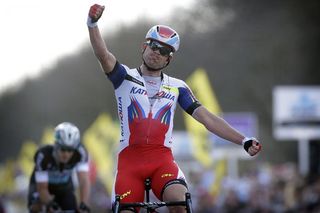
Did Flanders miss Boonen and Cancellara?
The Tour of Flanders got its first taste of future without Tom Boonen and Fabian Cancellara and, with the retirement of both riders not too far away, their absence is something that fans and riders will have to get used to.
Get The Leadout Newsletter
The latest race content, interviews, features, reviews and expert buying guides, direct to your inbox!
It was the first time that both of the riders didn't take to the start of the Flemish classic in more than a decade, and it had an almost overwhelming impact on the race. The race didn't really kick off until the final 50 kilometres when the day's break was finally brought back. Team Sky were perhaps the most dominant at the front but Geraint Thomas lacked the legs to finish off the work. With a number advantage throughout most of the race, many were looking to BMC to manage the chasing but they opted to sit back and let the others fight among themselves.
Etixx-QuickStep too seemed shy in the absence of their leader and didn't attack the race in their usual manner. The apparent disappearance of form of the usually aggressive Sep Vanmarcke and Jürgen Roelandts, who both struggled to keep up the pace, also had an impact on the race.
The 2015 Tour of Flanders was like a flock without its shepherd and after so much dominance from Boonen and Cancellara in the last 10 years it may take some time for the balance to redress. (SO)
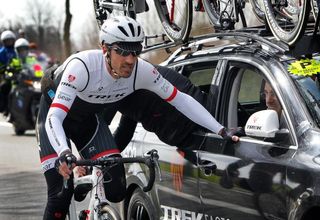
Should we re-think neutral service?
Crashes are part and parcel of bike racing but we don't often see cars getting involved. Unfortunately for Jesse Sergent and Sébastien Chavanel, they found themselves on the blunt end of some bad driving in Flanders. They are two separate incidents with entirely different factors but with two crashes like this occurring in one of the biggest races of the year, should we reconsider how neutral service is delivered and the rules surrounding the race convoy?
It is unclear why, in the case of Sergent's accident, the neutral service car was trying to overtake the leaders. With so much time between themselves and the peloton, there was little need for it. In many races, vehicles must get permission to pass the break. We don’t know if this occurred prior to the incident but perhaps car movement should be better regulated and in the tights confines of a cobbled classic, are neutral service motorbikes the way to go?
Chavanel's crash was a slightly different story. The FDJ car had pulled over in a tightly packed convoy when the Shimano car shunted it from behind. Again, the exact details of the incident are not known, perhaps the Shimano driver was distracted by something but it brings into question the regulations surrounding the race convoy. Perhaps a simple measure stating that a stopped car must use its hazard lights may have been enough to avoid the crash.
When cars and riders are in such close proximity there are always going to be dangers but more needs to be done to safeguard the safety of riders and drivers. (SO)
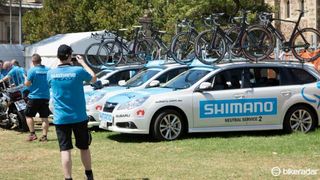
Too much too early for Sky?
Of all the teams with a serious contender for victory, Team Sky maintained probably the biggest presence at the front of the Tour of Flanders peloton. Geraint Thomas was the team's big leader and, after his performances the week before, he was to many the race favourite.
Used to being able to control the bunch in a Grand Tour, the British outfit took on a similar approach. But, when it came to the crunch, Thomas was left out in the cold. It was telling that almost all the major teams – Etixx-QuickStep, Lotto-Soudal, Astana and BMC – all had more than one rider in the first group when the action kicked off in the final 20 kilometres, but not Sky.
Katusha were the major exception, with only Alexander Kristoff in the front group. While Kristoff showed that it is possible to defeat the numbers, racing is much harder when the odds are against you.
Sunday wasn't the first time that Team Sky have employed the tactic and seen it go up in smoke. They did something similar at Milan-San Remo two weeks ago and although a crash saw them lose two riders they continued to push on the front, leaving an exhausted Thomas to try and position Ben Swift for the sprint. Swift could only manage 13th in the end, one place better than Thomas at Flanders.
While their riders may be coming of age and producing some results, perhaps their tactics on the cobbles still need some refinement. (SO)
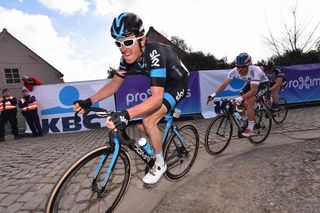
Benoot and Lotto-Soudal outshine Etixx-QuickStep
Lotto-Soudal maintained their recent tradition of gamely seeking to blow the Tour of Flanders open long before the final circuit over the Kwaremont and Paterberg, and though they again fell short of the big prize – their last Ronde win remains Peter Van Petegem's in 2003 – their commendable approach did at least yield a fifth-place finish for 21-year-old debutant Tiesj Benoot.
Lars Bak, a pugnacious André Greipel and the precocious Benoot were all on the offensive, and though leader Jürgen Roelandts (8th) couldn't follow the winning move over the Kruisberg, there was a broad smile on Marc Sergeant's face as he spoke to the press in Oudenaarde’s market square after the race.
Over at Etixx-QuickStep, failing to win the Ronde is usually a cause for inquest, though Patrick Lefevere was putting a brave face on Niki Terpstra's second place finish, and the absence of Tom Boonen, Zdenek Stybar's dental problems and Stijn Vandenbergh's crash were certainly all mitigating factors.
Having dissected the team's internal politics on the eve of the race, however, L'Équipe revisited the issue on Monday morning, and was stinging in its analysis of Terpstra's willingness to collaborate with Kristoff in the finale, which it described as an act of vanity. "He was already too happy just to confirm his ascendancy on the QuickStep team a week before Paris-Roubaix," the newspaper noted archly.
Whether that truly was the case or not, there was certainly no doubt that Lotto-Soudal were all pulling resolutely in the same direction, and it Roelandts himself who encouraged Benoot to clip off the front in the last two kilometres to take 5th. As individuals, of course, Roelandts and Greipel are not on quite the same level as Terpstra and Stybar, and so Lotto have no real option but to race devotedly as a unit – though if Benoot's progress continues, Sergeant's team may yet have a star to match any in the QuickStep firmament in the years ahead. (BR)
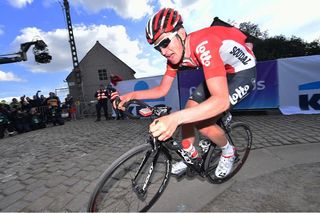
BMC's big tactical mistake
Greg Van Avermaet's third place behind Kristoff and Terpstra left him trying to see his glass of post-race consolatory beer as half full. But yet again the nicest Belgian in the peloton was left a step or two from the top of the podium
Van Avermaet again confirmed he has the ability to be amongst the best Classics riders in the world but still lacks that little bit needed to be a big-race, Monument winner. Kristoff and Terpstra have both made the step up in the last two seasons. Van Avermaet is still a Classics contender, not a Classics winner.
Hindsight-inspired race tactics are easy to make, especially the day after the race, but the truth is that BMC faltered when Terpstra and Kristoff surged clear with 28km to go.
Van Avermaet had Jean-Pierre Drucker, Daniel Oss and Marcus Burghardt but they stayed at the back of the chasing group during the 10km of wide roads before Oude Kwaremont and the Paterberg. They would have been better working to close the gap before the final climbs, so that Van Avermaet could have tried to make it across the gap on the Oude Kwaremont and the Paterberg or at least before the finish. Van Avermaet also made a significant mistake after the Oude Kwaremont by launching an attack instead of trying to inspire the chase.
If Van Avermaet had been 10 seconds closer before starting his chase with Sagan after the Paterberg, it could have been enough to give him a chance of victory, instead of yet another podium place. (SF)
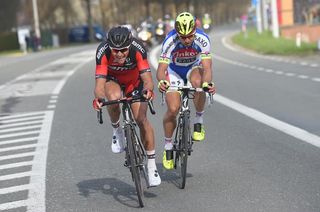
Sagan left on his own
Peter Sagan has suffered a tough few weeks in races and inside his new Tinkoff-Saxo team but had a good if disappointing day at the Tour of Flanders.
The young Slovakian has lost his natural touch and ability to win at ease, while Bjarne Riis and been dumped out of the team he created, leaving the team rudderless in the height of the Classics campaign. Yet he arguably produced his best performance of the spring by finishing fourth at the Tour of Flanders.
He looked one of the strongest riders in the race when he spun his way cross to Greg Van Avermaet (BMC) on the Paterberg. He paid for it in sight of the line after chasing with the Belgian for the last 13km of the race, but he still had the legs to out-performed Thomas, Pozzato, Degenkolb and Boom, who were behind him in the chase group.
Unfortunately for Sagan, he had to do it all on is own. The strongest teams and many of his direct rivals, had support riders. Sagan was alone in the front group of 54 that formed in the finale and had to ride defensively before playing one card.
Sagan's last card is more like a prince of clubs than the ace it used to be, but he showed that he has kept his head and his legs, while many of those around him at Tinkoff-Saxo are losing theirs. (SF)
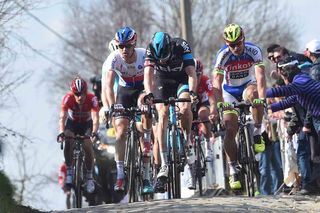
This year's Tour of Flanders was the fourth edition of the race on the 'new' route, without the Geraardsbergen finale and with the double loop of the Oude Kwaremont and the Paterberg before the final flat 13km roads to the finish in Oudenaarde.
The debate on which route produces the best race is still on going, with traditionalists suggesting the new tougher finale makes for a more tactical and so less-entertaining race. However, there is little debate that the Oude Kwaremont-Paterberg double whammy is pretty special and a great place to watch the race.
It seems the riders and their tacticians are finally starting to understand and unlock the secrets of the route. Everyone now knows the first assault of the Oude Kwaremont-Paterberg makes a huge selection with 50km to go and that it can be launch pad to victory the second time. In between are the Koppenberg, the Mariaborrestraat two-kilometre sector of cobbles, the Steenbekdries climb, the Tienberg and the Kruisberg. Individually or in combination, they offer numerous possibilities.
This year, Terpstra made his move after the Kruisberg, as everyone caught their breath but as the road still rose gradually. He committed to the move and knew he had a chance when Kristoff joined him and also did some big turns. It caught their rivals off-guard, as many awaited or even feared the final selection the Kwaremont-Paterberg would cause. It was a costly mistake letting the two go clear but the attack paid off big time for Kristoff and even Terpstra. It also confirmed that there is still room for interpretation and inspiration if a rider has the intelligence and bravely to match their physical strength.
Perhaps the only change to the route that could make for an even better race is a different run-in to the finish in Oudenaarde. One last climb inside the final 10 kilometres could inspire someone to make a solo attack, just as the Bosberg once did. The Koppenberg would be perfect and is only a few kilometres from the finish. (SF)
Honourable mentions
Despite lasting close to seven hours, covering hundreds of kilometres and with a field of 200 riders, each Classic ends with only one big winner, who grabs the glory, collects the flowers and the kisses and takes home the WorldTour points and big contract pay increase.
However each Classic is also packed with special moments and riders who deserve honourable mentions. These are the Cyclingnews nominations for the Tour of Flanders honourable mentions.
Filippo Pozzato (Lampre-Merida) finished 12th and showed he is worth some kind of contract for 2016 and leadership role at Paris-Roubaix.
Nelson Oliveira (Lampre-Merida) finished his first major Classic after seven attempts on Sunday and proved valuable help to Pozzato.
Zdenek Stybar (Etixx-Quickstep) ended the race ruing what could have been, without his front teeth and with a point to prove. But he will have learnt not to let Nikki Terpstra land the first attack.
Lars Boom, Laurens De Vreese, Alexey Lutsenko and the rest of the Astana Classics squad deserve a special mention. They may be riding for their futures but they did it well and as a team on Sunday. (SF)
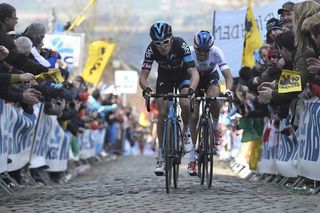
Paris-Roubaix can't come quickly enough for Vanmarcke, Sky and Boom
The Flanders-Roubaix double has become so common during the Boonen-Cancellara duopoly of the past decade – they have achieved it four times between them – that it has often felt as if the cobbled classics had been put to bed after the first weekend in April. After Cancellara's dominant Ronde victory in 2010 or Boonen's cool-headed triumph in 2012, for instance, who truly believed the following Sunday would throw up a different winner? For all its reputation as a lottery, the Queen of the Classics has a habit of simply smiling upon the strongest man rather than rewarding invention.
This time around, however, with Boonen and Cancellara out of action, and given Kristoff's mixed back catalogue on the pavé of northern France, there is a wider array of genuine contenders than normal, a greater uncertainty about the outcome and greater scope for tactical complexity. And, most intriguingly of all, there are a number of riders who fell flat at the Tour of Flanders who will be desperately seeking to make amends next weekend.
Chief among them is Sep Vanmarcke, who was one of the top favourites for Flanders but then inexplicably missed the selection on the Taaienberg and finished a lowly 53rd. Two years ago he followed up an off-colour Ronde by pushing Cancellara to the limit in Roubaix, and he will hope for a similar seven-day turnaround here. Peter Sagan, too, will hope that he can put a different slant on his spring.
For Geraint Thomas, Bradley Wiggins and Sky, Paris-Roubaix is a chance to dream it up all over again after a Tour of Flanders that promised so much and delivered so little. Crashes hampered Lars Boom's Flanders build-up, but he still took sixth place on Sunday and will be better again come next Sunday, as will John Degenkolb. Greg Van Avermaet and Etixx-QuickStep, too, will relish the opportunity for a do-over. (BR)
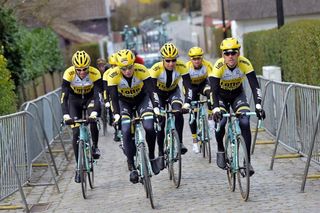
Most Popular


